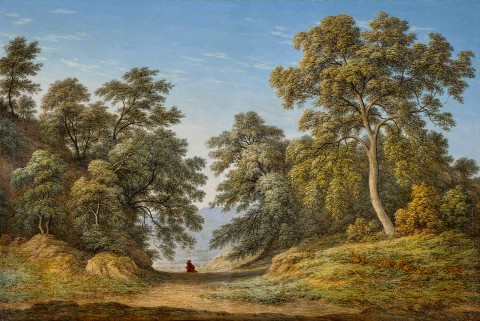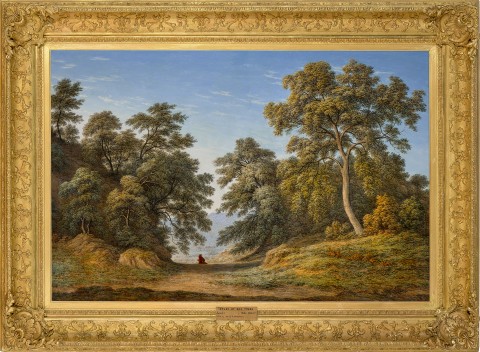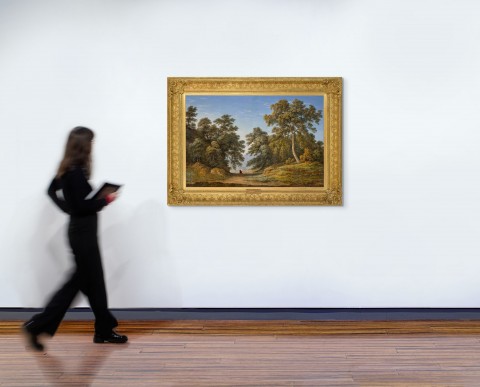STUDY OF OAK TREES, c.1840
JOHN GLOVER
oil and collage on canvas
75.0 x 112.0 cm
bears inscription on plaque: STUDY OF OAK TREES / John Glover / lent by Mr G. R. Chapman
frame: William Wilson, Launceston
Thomas and Catherine Chapman, Sunnyside, New Town, Hobart
Thence by descent
George S. Chapman, Hobart, acquired in 1884
Thence by descent
George R. Chapman, Hobart
Thence by descent
G. Robin Chapman, Hobart
Thence by descent
Geoff Chapman, Hobart
Thence by descent
Peter Chapman, Hobart
Estate of the above
This oil painting was produced in the later years of John Glover’s life, following his long and successful career as a landscape artist and teacher in England and his emigration to Van Diemen’s Land in 1831, aged sixty-four. There he had turned his attention to interpreting the Australian bush, both as it had been managed by the Aboriginal custodians, and as it was being transformed by British newcomers for pastoral and agricultural purposes. Throughout these years he also continued to paint far-distant scenes, based on recollections of his travels throughout Britain and Europe, prompted by earlier sketches contained in the 104 small sketchbooks that he had brought with him.1
This tranquil view, possibly Italian, along a country road is interrupted by a steep bank of trees of varying ages and forms. Framed by overhanging branches, a woman and child walk in shadow, soon to emerge towards us into open land and sunshine. Despite the posthumous title Study of oak trees, c.1840 given on the frame, this is a finished painting of exhibition quality, showing Glover’s skilful application of thin oil paint akin to watercolours and his use of a split brush to evoke leafy texture. Unusually, the figures have been painted onto paper; no other example of collage in his oeuvre is known.2 While the paper outline is now noticeable, this addition is valuable evidence of a working method previously unrecorded and provides a human focus at the crucial point in the composition. The cerulean sky and muted greens ofthe landscape have recently been revealed after being hidden for decades by layers of varnish. It now glows in the manner Glover originally intended.
This painting has a direct provenance from Thomas Chapman and his wife, who arrived in Van Diemen’s Land in late 1841. This is around the date this painting was created although it is unknown when it entered their collection. A merchant by trade and an opponent of transportation, Chapman became a politician and subsequently the fifth Premier of Tasmania (1861–63). Study of oak trees passed down the family to Peter Chapman, a respected scholar and teacher of Tasmanian and Australian history who died earlier this year. His numerous publications included an article on ‘John Glover’s migration to Tasmania’.3
The painting remains in its original William Wilson frame. Wilson was a Launceston-based ‘Carver & Gilder, Looking Glass, Picture Frame and Composition Ornament Manufacturer, Upholsterer’4 and ‘manufacturer of every description of Ornamental Furniture’, who arrived in the colony in 1842. Less well-known than his Hobart counterpart Robin Hood, Wilson created elegant frames for Glover, Frederick Strange and Robert Dowling among others.5
1. 'Hill and I were the whole of the evening looking over the two books he [Glover] had placed before us. He told us that he had 104 of such…’ G.T.W.B. Boyes (ed. Peter Chapman), The Diaries and Letters of G. T. W. B. Boyes: Volume 1 1820-1832, Melbourne: Oxford University Press, 1985, pp. 421 – 22
2. Experts John McPhee and David Hansen have not previously seen collage used. The quality of the painted figures suggests that these are by Glover.
3. Chapman, P., ‘John Glover’s migration to Tasmania’, The Art Bulletin of Tasmania, Tasmanian Museum and Art Gallery, Hobart, 1985, pp. 22 – 33
4. See Robyn Lake and Therese Mulford, ‘William Wilson: Rediscovered Tasmanian Frame maker’, Australiana, vol. 23, no. 1, Feb. 2001. pp. 4 – 11
5. The name plate on the frame indicates that this work was included in a loan exhibition when owned by George R. or G. Robin Chapman.
ALISA BUNBURY


